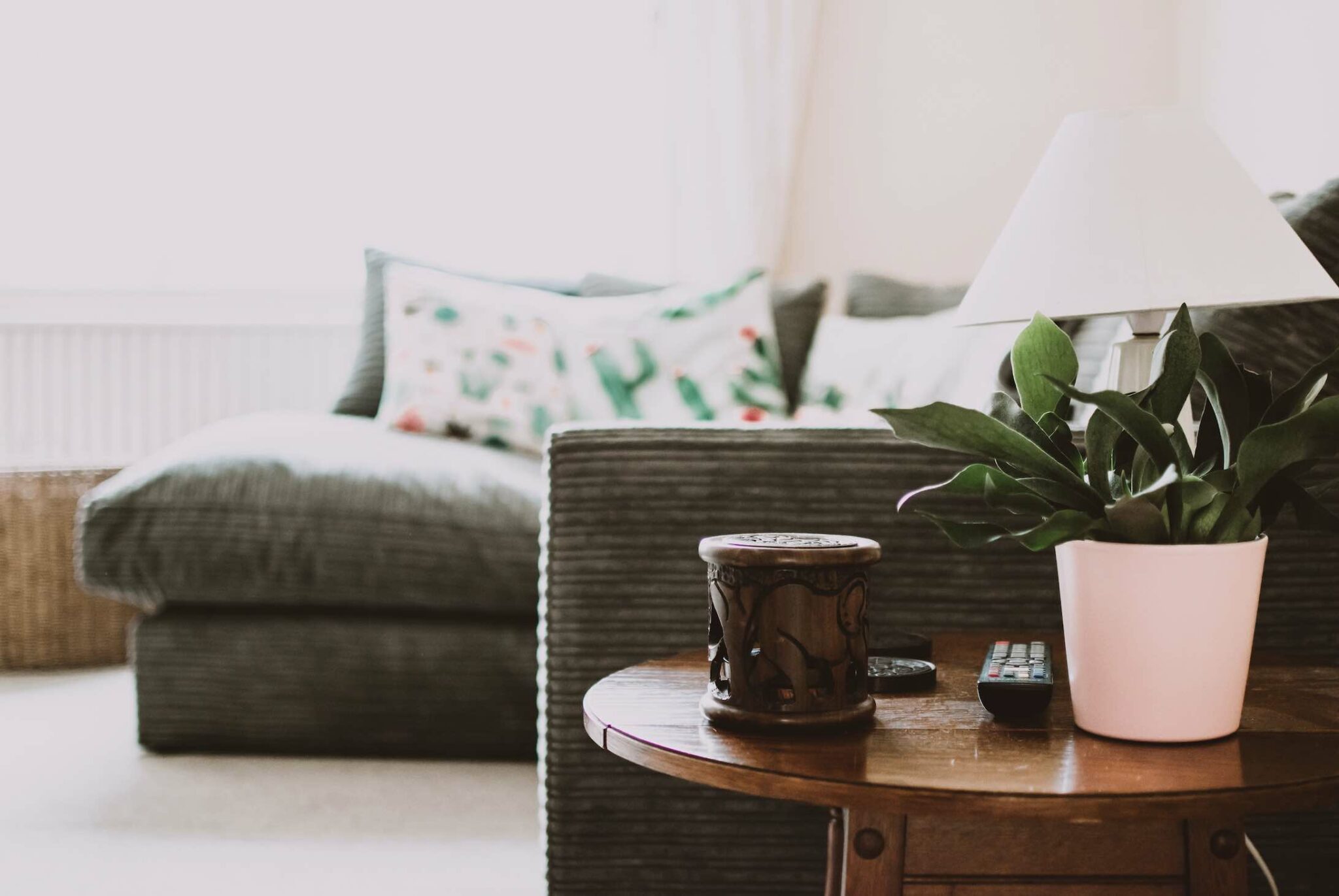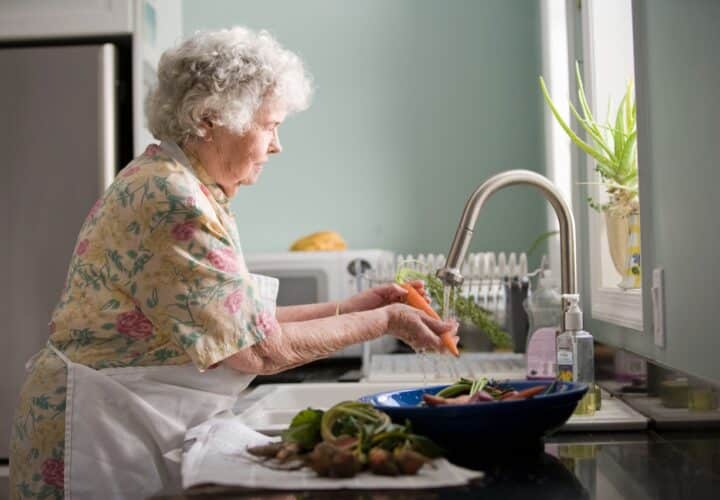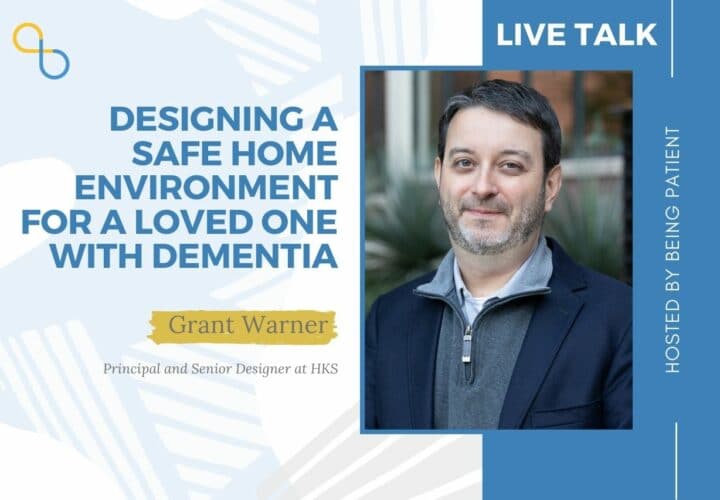Here's an expert-vetted list of ways to help keep Alzheimer's patients safe at home, from home modifications to dementia-friendly lighting and decór choices.
Adapting to the physical, cognitive and behavioral changes associated with dementia is key to living well — and making a home environment safer and easier to navigate plays a central role. However, creating a safe, comfortable home environment for a person living with dementia isn’t just about shopping up the right homewares and creating the right design features: Experts say it also takes some planning ahead.
How long can people with Alzheimer’s disease live at home?
Routine and familiarity are critical to the care of a person living with dementia. Experts say making home modifications early on may help individuals ease into the environment, learn their way around, and grow accustomed to it over time. Enhancing safety and comfort could help them live at home longer.
Whether a person with dementia will live at home throughout their illness, relocate to a smaller, more aging-friendly residence, or to a long-term care community, certain strategies, big and small, can offer more support, safety and independence. Here are five expert-recommended starter steps.
How do you create a safer home environment for Alzheimer’s and dementia patients?
1. Simplify and organize
According to Clinical Nurse Specialist Sarah Dulaney at the University of California San Francisco, when it comes to making a living space safer and easier to navigate for a person with Alzheimer’s disease or related forms of dementia, simplifying and organizing is a good place to start.
Over the years, things like mail, gifts never used, clothes and magazines tend to accumulate and fill up the house. Concentrating, processing information and finding things at home becomes increasingly difficult for anyone living in a messy environment, and for people living with dementia, clutter can be especially disorienting, not to mention unsafe.
Anything on the floor — especially in walkways — could lead to falls, and experts say paring back years worth of possessions and keeping a house organized is a good first step. Trip hazards aren’t limited to clutter: According to the CDC’s safety recommendations list, coiling or taping appliance and phone wires and extension cords to the baseboards and removing throw rugs — or ensuring they have non-skid backs — can reduce some of the risk.
Now that clutter is out of the way, needed items still have to be easy to find. Dulaney recommended keeping everyday items in consistent locations and in plain sight. She encouraged caregivers to observe the tendencies of people in their care and modify their home environment accordingly. For instance, large, easy-to-understand labels could help people identify the correct objects if they often confuse toothpaste with lotion or shaving cream.
Home Safety Services has created a handy check list to address the risk of falls at home. Another helpful resource is a list compiled by Dementia Enabling Environments with advice on creating a dementia-friendly environment.
2. Consider light and contrast to prevent falls
Vision problems grow more common with aging, and because dementia can affect parts of the brain that handle visual information, it often compounds age-related vision impairment. This can mean depth perception issues, a smaller field of vision, diminished tolerance of glare, and difficulty distinguishing one object from another.
According to dementia care expert Jennifer Brush, good lighting is key, day and night. Adjusting the lighting in a person’s living space may not only help them navigate their surroundings more easily, it can also ease Alzheimer’s and dementia-related confusion, anxiety and aggression.

“Lighting should be even and consistent,” Brush wrote for the Ohio Council for Cognitive Health, “Try to keep light at a similar level throughout each room of the house and from room to room, that means no dark corners or dark hallways. Uneven lighting, patterns caused by bright light, and shadows can cause agitation and confusion.”
Even on a bright day, some spots in the house, like the closet, may require extra lighting, and Brush recommended products like pressure sensitive switches on the door frames of closets that offer automatic lighting. Cheaper alternatives include battery-powered closet lights with built-in motion detectors or manual switches. For walkways to the bathroom, she suggested installing nightlights or nighttime LED lighting.
Color contrasts can help with diminished vision and depth perception. Dulaney suggested using tableware that is easy to distinguish from the surface of the table, placing stickers or colorful tape at the edge of steps in a staircase, and draping a towel over a glass shower door to make them easier to see.
Because glares can be disorienting and contribute to hallucinations, Brush said to consider dressing windows with shades to filter or block light during the day, though some are better suited for a dementia-friendly environment than others.
“Vertical and horizontal blinds are not the best choice because they create slits of light and dark, which can be very disorienting to people with dementia,” Brush wrote. “If they are metal, the light may reflect off the blinds, causing even more glare. Window treatments using sheer curtains or shades allow light to be diffused without totally blocking the view. Windows should also have a means of completely blocking out the view, such as curtains or closed shades. The reason for this is that windows can act like mirrors at night, which can be disturbing to people living with dementia.”
3. Addressing smoke and fire hazards in the kitchen
Accidents are prone to happen in the kitchen: Grant Warner, who specializes in designing senior living spaces for the architectural firm HKS. said people could sometimes leave the stoves on for hours at a time, filling the house with smoke and igniting fires.
For smart alarm systems, Warner suggested automatic shut-off technologies for stoves and microwaves from FireAvert. He also recommended automatic fire extinguishing systems like the Guardian G300B as another line of defense.
According to Dulaney, being aware of these fire hazards is critical, but it is also important for individuals to maintain their independence to the extent possible in carrying out daily tasks, such as preparing a meal.
“My philosophy is that you want people to be able to do what they can do for as long as possible,” Dulaney said. “If they can use a microwave, a toaster safely, I would want them to continue to be able to do that, but you might take the knobs off the stove at night if they’re going to wake up and try to cook something.”
People could also adapt with safer approaches to preparing a meal. While knives could be a hazard, making a task like chopping vegetables tricky, the individual could still help with chores like peeling foods, setting the table and putting away dishes. Instead of preparing tea with a kettle on the stove, switching to an electric kettle that turns off automatically when the water boils or dividing the task between care provider and the person under their care are good options.
“You can try to make the task safer for them in a way that allows them to continue to do it,” Dulaney said.
Also, be sure you have carbon monoxide detectors and other standard safety measures throughout the home and that your fire safety measures are up to code.
4. Installing grab bars and other safety modifications in the bathroom
While slips and hot water burns can happen in the bathroom, there are various adjustments that can reduce risk.
Experts recommend adhesive strips in showers and bathtubs to prevent slips, replacing a step-over bathtub with a walk-in shower or installing a bench. Instead of using a towel rack as a handle in the bathroom, colorful grab bars give people living with dementia a sturdier and more visible option for something to hang on to in order to prevent a fall.
As Alzheimer’s disease and related forms of dementia may alter people’s sense of touch, experts also recommend installing scald protection features on faucets, which detects if water reaches unsafe temperatures and stops the flow of water automatically.
5. Addressing wandering inside and outside a home
Restlessly pacing, getting lost and confused: Wandering is a common symptom of dementia that could lead to dangerous situations. If a person is not in immediate danger, families should first try to address their wandering with gentle work-arounds.
“If they’re just wandering into the kitchen to get a snack, maybe you just leave an easy-to-eat snack on the counter, and they get that and they go back to bed,” Dulaney said. “You want to do the least restrictive thing first.”
However, a person who wanders out of a home can get into potentially life-threatening situations. Dulaney recommended first installing door knob safety covers for exterior doors, in addition to purchasing a GPS tracking bracelet. Deadbolts could be an alternative if door knob safety covers aren’t effective. Either way, a person should not be left alone at home.
She also recommended electronic monitors equipped with motion sensors. As alarms can be frightening, she said remote alarms that alert a caregiver or family member are a better option. Bells or chimes attached to a door could work as well, especially for light sleepers.
According to Jennie Clark, a gerontologist at Stanford Health Care, families that plan to set up home security systems should always seek consent from their loved ones, as long as the person still has the capacity to make decisions for themselves. But, some may not welcome the plan. In that case, she noted that the family should seek common ground and ask a loved one: “What are your goals for yourself? What are your hopes in terms of where you live?”
“And if they say, ‘I want to stay at home. Please don’t ever put me in a nursing home,’ or, ‘Please don’t ever move me to assisted living,’” Clark said, “then you say, ‘I really want to make that happen for you. That’s important for me too. But in order to do that, there are some things that are my responsibility in helping care for you that I need to do, and so, can we talk about these things and are you okay with these things?’”
It helps to write down the plan on a piece of paper where family members agree to setting up a monitoring system. “Nothing has to be forever, so you can try it and see how it works,” Clark said. “If it works well, that’s great.” If it doesn’t work, Clark recommended consulting with a loved one’s neurologist or primary care physician to discuss ways to move forward with an appropriate care plan.
“Advanced care planning and care planning in general is becoming very popular — thankfully, and it should be,” Clark said. “Many physicians are being trained on that, so they’re able to have these discussions with their patients.”
One last key step: Look into financial assistance for dementia-friendly home modifications
Planning ahead can pay off: Caregiving consultant Lydia Chan adds, “Don’t pay everything out of pocket until you check if you qualify for a home modifications grant. Consider that some grants only cover specific modifications, so you may have to apply for more than one—a small price to pay in comparison to taking on the entire financial burden yourself.”



